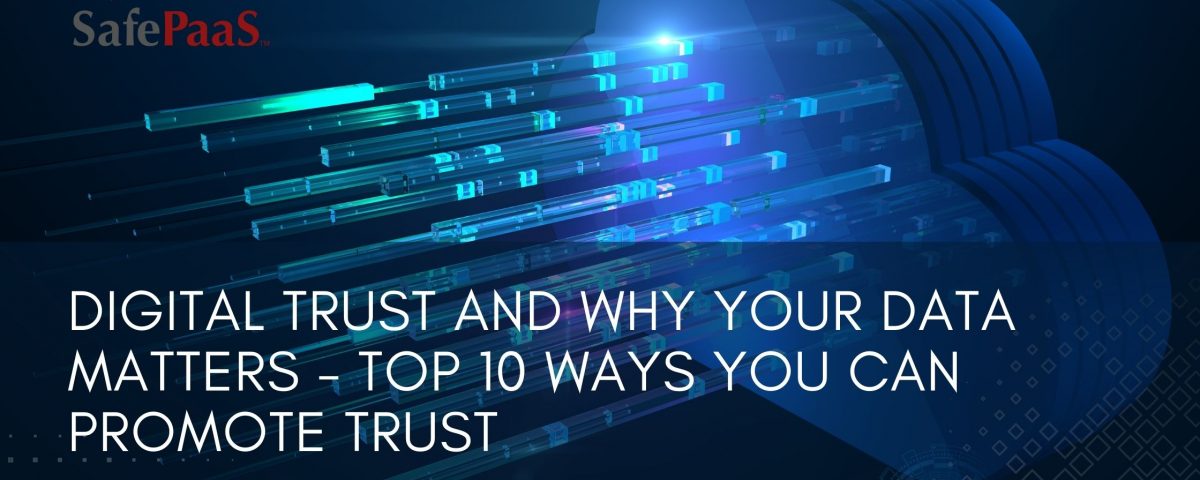Digital Trust and Why Your Data Matters


Digital Trust and Why Your Data Matters
Top 10 Ways You Can Promote Trust
In our digital world, where online interactions shape our lives and drive business operations, trust is the glue that holds everything together.
Whether you're a consumer, a business owner, or part of an organization, trust forms the foundation of successful relationships in the digital world.
At the very heart of this trust lies data – a powerful asset that not only shapes your online experiences but also determines the level of confidence, reliability, and integrity you have in digital transactions.
According to ISACA, the key factors that contribute to digital trust include:
Quality: You expect products and services to meet or exceed your expectations. Your data plays a crucial role in ensuring that businesses deliver on their promises and provide you with high-quality experiences.
Availability: Timely and accurate access to information is essential for making informed decisions. Your data needs to be readily accessible whenever required, without any unnecessary delays or roadblocks.
Security and Privacy: You want assurance that your data is safe from unauthorized access, breaches, or misuse. Strong security measures and strong privacy protections are necessary to safeguard your sensitive information and maintain its confidentiality.
Ethics and Integrity: You value upholding standards and demonstrating integrity in your business processes. Trustworthy businesses adhere to their values and operate with transparency and honesty.
Transparency and Honesty: You expect transparency about how your data is collected, used, and shared. Organizations that are open and honest about their data practices build trust and credibility with their users.
Resiliency: In a rapidly evolving digital landscape, you need assurance that your business can adapt to challenges and embrace technological advancements while remaining stable and secure.
While everyone in an organization has a role to play in promoting digital trust, the ultimate responsibility falls on the shoulders of its leaders. C-level executives must prioritize digital trust as a strategic imperative and ensure its integration into every aspect of operations to uphold strength and sustainability over the long term.
But how can you ensure that your data governance and application controls contribute to fostering trust in the digital ecosystem? Here's how:
1. Policy-Based Access Control: Data governance safeguards sensitive data and critical systems, ensuring that only authorized users can access them through policy-based access controls (PBAC), thus reducing the risk of data breaches and cyberattacks and enhancing user confidence in data protection measures.
2. Pin Point Visibility: Data Governance gives organizations visibility into user access rights and permissions, allowing for effective monitoring and auditing of user activities through access logs and audit trails. This transparency fosters trust among users by demonstrating responsible access management practices.
3. Regulatory Adhearance: Implementing Data Governance ensures organizations adhere to regulatory requirements and industry standards governing data privacy and security, such as GDPR or HIPAA, thereby demonstrating a commitment to protecting user data and upholding privacy rights, which builds trust among users and stakeholders.
4. Proactive Risk Management: Data Governance enables organizations to proactively identify and mitigate potential risks associated with user access and application usage, such as implementing multi-factor authentication (MFA) and enforcing least privilege principles. This reduces the risk of fraud, errors, and resource misuse, ultimately enhancing trust and confidence in the organization's security practices.
5. Seamless User Experience: Effective Data Governance contributes to a seamless and user-friendly experience by ensuring users access needed resources appropriately and streamlining processes like self-service access request portals. This enhances user satisfaction and confidence in digital platforms, fostering trust and loyalty.
6. Granular Access Logging: Data Governance facilitates granular access logging, capturing detailed information about user access, actions, and system events. This comprehensive audit trail provides insights into user activities, enhancing transparency and accountability and building trust.
7. Real-Time Monitoring: Data Governance solutions include real-time monitoring capabilities, allowing organizations to detect and respond quickly to suspicious activities or security incidents. By monitoring user behavior in real time, organizations can maintain the accuracy and timeliness of audit data, thereby bolstering trust.
8. Enforcement of Access Policies: Data Governance solutions enforce access policies and controls to ensure users only have access to necessary resources, minimizing the risk of unauthorized access or data breaches. By maintaining the integrity and accuracy of audit data, organizations build trust with users and stakeholders.
9. Regular Auditing and Review: Data governance practices involve regular auditing and review processes to assess the effectiveness of access controls and identify improvement areas. This ongoing evaluation ensures compliance with security policies and regulatory requirements, enhancing trust in data management practices.
10. Quality Audit Data: Data governance integrates with IT Service Management (ITSM) tools to provide comprehensive visibility into cybersecurity threats and facilitate trust with auditors. This integration enhances the quality and context of audit data, ultimately bolstering trust in data governance measures.
Your data is the lifeblood of digital trust. By prioritizing data protection, privacy, and Data Governance, you can build and maintain trust with stakeholders, laying the foundation for sustainable growth and success in the digital age. So, remember to demand transparency, accountability, and reliability in how your data is handled – because when it comes to digital trust, your data matters most.
Ready to take the first step toward cultivating trust?
Recommended Resources

Policy-based Identity Governance Guidebook
Many organizations grapple with IGA processes, like creating and managing roles, assigning and reviewing access entitlements, and handling access requests. The primary cause is that organizations follow the wrong approach to IGA, particularly around creating and managing roles.

Complete Guide to Data Access Governance
Data access governance refers to managing access to your organization's data assets and the
processes, policies, and controls to ensure data quality, integrity, availability, and security. It involves defining the roles, responsibilities, and processes related to data management, including data collection, storage, usage, access, and disposal.

PBAC vs RBAC
Policy-based access governance offers the agility and precision needed to secure today's complex business environments. Making access decisions based on real-time context and risk factors helps organizations stay ahead of security challenges, adapt to evolving requirements, and ensure compliance. In essence, it's a forward-looking approach that promises to enhance security, reduce risks, and streamline access management in the digital age.

